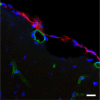The betaine/GABA transporter and betaine: roles in brain, kidney, and liver
- PMID: 24795654
- PMCID: PMC4006062
- DOI: 10.3389/fphys.2014.00159
The betaine/GABA transporter and betaine: roles in brain, kidney, and liver
Abstract
The physiological roles of the betaine/GABA transporter (BGT1; slc6a12) are still being debated. BGT1 is a member of the solute carrier family 6 (the neurotransmitter, sodium symporter transporter family) and mediates cellular uptake of betaine and GABA in a sodium- and chloride-dependent process. Most of the studies of BGT1 concern its function and regulation in the kidney medulla where its role is best understood. The conditions here are hostile due to hyperosmolarity and significant concentrations of NH4Cl and urea. To withstand the hyperosmolarity, cells trigger osmotic adaptation, involving concentration of a transcriptional factor TonEBP/NFAT5 in the nucleus, and accumulate betaine and other osmolytes. Data from renal cells in culture, primarily MDCK, revealed that transcriptional regulation of BGT1 by TonEBP/NFAT5 is relatively slow. To allow more acute control of the abundance of BGT1 protein in the plasma membrane, there is also post-translation regulation of BGT1 protein trafficking which is dependent on intracellular calcium and ATP. Further, betaine may be important in liver metabolism as a methyl donor. In fact, in the mouse the liver is the organ with the highest content of BGT1. Hepatocytes express high levels of both BGT1 and the only enzyme that can metabolize betaine, namely betaine:homocysteine -S-methyltransferase (BHMT1). The BHMT1 enzyme removes a methyl group from betaine and transfers it to homocysteine, a potential risk factor for cardiovascular disease. Finally, BGT1 has been proposed to play a role in controlling brain excitability and thereby represents a target for anticonvulsive drug development. The latter hypothesis is controversial due to very low expression levels of BGT1 relative to other GABA transporters in brain, and also the primary location of BGT1 at the surface of the brain in the leptomeninges. These issues are discussed in detail.
Keywords: hepatocytes; leptomeninges; methyl donor; mouse models; osmolyte; renal medulla; synapse.
Figures





Similar articles
-
The betaine-GABA transporter (BGT1, slc6a12) is predominantly expressed in the liver and at lower levels in the kidneys and at the brain surface.Am J Physiol Renal Physiol. 2012 Feb 1;302(3):F316-28. doi: 10.1152/ajprenal.00464.2011. Epub 2011 Nov 9. Am J Physiol Renal Physiol. 2012. PMID: 22071246
-
Structural and molecular aspects of betaine-GABA transporter 1 (BGT1) and its relation to brain function.Neuropharmacology. 2019 Dec 15;161:107644. doi: 10.1016/j.neuropharm.2019.05.021. Epub 2019 May 18. Neuropharmacology. 2019. PMID: 31108110 Review.
-
Hypertonic activation of the renal betaine/GABA transporter is microtubule dependent.Kidney Int. 2001 Jun;59(6):2182-91. doi: 10.1046/j.1523-1755.2001.00733.x. Kidney Int. 2001. PMID: 11380820
-
Mutation of a single threonine in the cytoplasmic NH2 terminus disrupts trafficking of renal betaine-GABA transporter 1 during hypertonic stress.Am J Physiol Renal Physiol. 2014 Jul 1;307(1):F107-15. doi: 10.1152/ajprenal.00085.2014. Epub 2014 May 14. Am J Physiol Renal Physiol. 2014. PMID: 24829506
-
Osmotic regulation of renal betaine transport: transcription and beyond.Pflugers Arch. 2004 Dec;449(3):227-34. doi: 10.1007/s00424-004-1338-6. Pflugers Arch. 2004. PMID: 15452713 Review.
Cited by
-
Reconstitution of GABA, Glycine and Glutamate Transporters.Neurochem Res. 2022 Jan;47(1):85-110. doi: 10.1007/s11064-021-03331-z. Epub 2021 Apr 27. Neurochem Res. 2022. PMID: 33905037 Free PMC article. Review.
-
Metabolome panels as potential noninvasive biomarkers for primary glomerulonephritis sub-types: meta-analysis of profiling metabolomics studies.Sci Rep. 2023 Nov 21;13(1):20325. doi: 10.1038/s41598-023-47800-7. Sci Rep. 2023. PMID: 37990116 Free PMC article.
-
CHDH, a key mitochondrial enzyme, plays a diagnostic role in metabolic disorders diseases and tumor progression.Front Genet. 2023 Aug 2;14:1240650. doi: 10.3389/fgene.2023.1240650. eCollection 2023. Front Genet. 2023. PMID: 37600654 Free PMC article. Review.
-
Treatment with Mefolinate (5-Methyltetrahydrofolate), but Not Folic Acid or Folinic Acid, Leads to Measurable 5-Methyltetrahydrofolate in Cerebrospinal Fluid in Methylenetetrahydrofolate Reductase Deficiency.JIMD Rep. 2016;29:103-107. doi: 10.1007/8904_2016_529. Epub 2016 Feb 23. JIMD Rep. 2016. PMID: 26898294 Free PMC article.
-
Comparative Transcriptome Analysis of Hens' Livers in Conventional Cage vs. Cage-Free Egg Production Systems.Vet Med Int. 2025 Mar 21;2025:3041254. doi: 10.1155/vmi/3041254. eCollection 2025. Vet Med Int. 2025. PMID: 40160973 Free PMC article.
References
Publication types
LinkOut - more resources
Full Text Sources
Other Literature Sources

